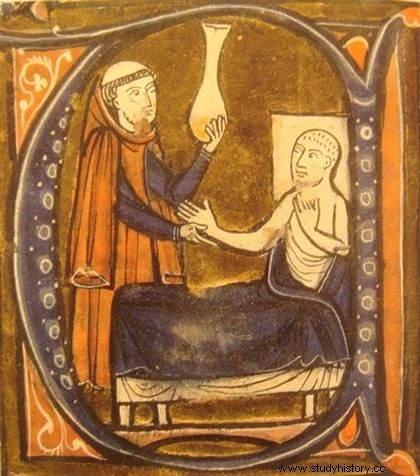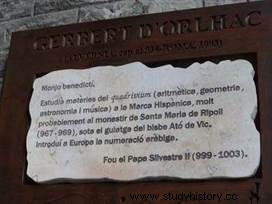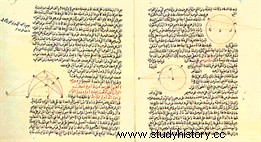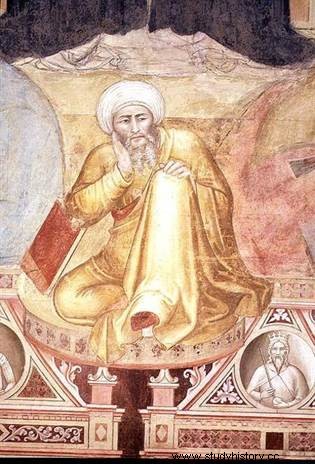 Medieval Spain, whether Al Andalus or that of the Christian kingdoms, is considered the privileged place ( with Sicily) of the transmission of Greek knowledge to the Latin West. The controversy surrounding the work of S. Gouguenheim, Aristote au Mont Saint-Michel (2008), however, showed that this question still provoked heated debates. Between those who deny or minimize the Arab contribution to this transfer of knowledge, and those who have a romantic vision of Al Andalus, where cultural exchanges took place in complete harmony, there is perhaps a happy medium. Indeed, Greek science and philosophy passed to the West through the Arabs, but the latter were translated. By whom?
Medieval Spain, whether Al Andalus or that of the Christian kingdoms, is considered the privileged place ( with Sicily) of the transmission of Greek knowledge to the Latin West. The controversy surrounding the work of S. Gouguenheim, Aristote au Mont Saint-Michel (2008), however, showed that this question still provoked heated debates. Between those who deny or minimize the Arab contribution to this transfer of knowledge, and those who have a romantic vision of Al Andalus, where cultural exchanges took place in complete harmony, there is perhaps a happy medium. Indeed, Greek science and philosophy passed to the West through the Arabs, but the latter were translated. By whom?
"The most learned philosophers in the world"
This quote is taken from the preface to the treatise on cosmology by a late 12th century English scholar, Daniel de Morley (1140-1210). He recounts his trip to Europe and his great disappointment when, in Paris, he discovers the scholars of the Episcopal School; he finds the latter similar to “very little children”, ignorant, and yet sure of their wisdom, guaranteeing the maintenance of their status. Daniel de Morley then decides to go to Toledo where, according to him, he will be able to listen to "the most learned philosophers in the world" dispense the quadrivium (arithmetic, music, geometry and astronomy). He returned to England a few years later with "a precious quantity of books".
Daniel de Morley's strong opinion illustrates a reality in the twelfth century:there is an opposition between the West, which draws inspiration from late encyclopedists (Boethius, Isidore of Seville , Cassiodore,…), and Toledo which, like the Arab and Muslim world, possesses knowledge unknown to the Latins since the High Middle Ages. In the 12th century, Toledo is no longer an Arab city, since it was taken in 1085 by Alfonso VI, but its libraries are full of the manuscripts on which Arab scholars worked. And there are still populations, Jews and Mozarabic, to translate these texts.
A Latin world in search of knowledge
In the 12th century, however, the gap in knowledge between Latins and Arabs was no longer as great as in the High Middle Ages, at the time of the School of Baghdad . Since about the year one thousand, we have witnessed an intellectual revival in the West, with figures such as Pierre Abélard (1079-1142), Guillaume de Champeaux (1070-1121) or Pierre Lombard (1100-1160). The Latin world is experiencing a boom at all levels, demographic, economic, urban, and it is the era of military conquests, with the Reconquista, the campaigns of the Normans of Italy and of course the First Crusade.
This change causes needs, which are primarily technical and intellectual, not religious, literary or legal. The Latin West lacks a system of explanation of the world, of references and theoretical treatises, as in medicine. Things that the Arabs have had for a long time, thanks in particular to their work on Greek knowledge. It is therefore necessary for the Latins to translate what the Arabs did, while the conquests allow them access to the rich libraries of the latter.
Gerbert d'Aurillac, first setter
The first eminent cleric who is interested in Arabic knowledge is not a translator, but rather a transmitter. Born around 945, he was taken during his training in Catalonia by Count Borrell of Barcelona. It was in Ripoll, with the help of the Bishop of Vic, that Gerbert discovered the manuscripts that would fascinate him. Indeed, at the time, Al Andalus was led by Caliph Al-Hakam II, whose library and taste for knowledge were renowned throughout the world. Catalonia has rather cordial relations with the Caliph of Cordoba, which allows porosity between the two states, and thus the circulation of knowledge. At Ripoll, the monks work on translated manuscripts, mainly treatises on astronomy and arithmetic. Back in France, Gerbert even commissioned a De multiplicatione et divisione from the Bishop of Girona. , which he brings from Catalonia. Gerbert d'Aurillac was finally elected pope in 999, under the name of Sylvester II. A plaque was recently placed in the monastery of Ripoll to celebrate its importance. 
The era of Gerbert, in the 970s, is also the one that saw the appearance of so-called "Arabic" numerals (Indian in fact) in Latin manuscripts, the oldest preserved being dated 976. Found in the north of ' Spain, it includes this comment:"we must know that the Indians have a very subtle ingenuity and that all other people bow before them in matters of arithmetic, geometry and other liberal arts" . The adoption of these figures, even if it is progressive, is a real revolution.
The first translations…in Italy
It is necessary to take a detour, even if we are supposed to discuss translations in Spain. Indeed, contrary to popular belief, the first translations did not take place on the borders of Al Andalus, but in Italy. They are the work of Constantine the African (1015-1087). His biography is largely legendary, but it is known that he was probably born in Ifriqiya and may have belonged to the small Christian community of Kairouan, where he learned medicine.
For unknown reasons (the Hilalian invasion?), Constantine emigrated to Italy where he was taken in by the Archbishop of Salerno and Robert Guiscard. Then, he goes to Monte Cassin, where he settles. There, he translated the fundamental works of the doctor Ali Abbas al-Majusi (10th century) and the treatises of a Jewish doctor from Kairouan, Iszrak al-Israeli. From Monte Cassino and Salerno, the renewed teaching of medicine spread in the 12th century.
The importance of the capture of Toledo
The period of the taifas, however unstable it may be, is also a time of strong emulation between the various emiral courts of Al Andalus. And Toledo, especially under the emirate of Al-Mamun (1038-1075), was a very rich and active place of knowledge. When the city falls into the hands of the Castilians, it is with it the wealth of its libraries that is available to curiosity, and especially to the needs of the conquerors. The latter thus discovered unknown books and treatises, such as Arabic versions of Greek texts translated in Baghdad in the 9th century, but also works by Andalusian scholars. It remains to translate them into Latin.
For translations, the Spaniards cannot rely on the Arabs themselves. First, because most of them have fled, refusing, as in other regions, to live under infidel domination. Moreover, the victors do not intend to show great tolerance, as the transformation of the mosque into a church shows, against the promise made. Most of the Muslim elite therefore emigrated, like the astronomer Al-Zarqali, who died in Seville around 1100.
The Latins therefore turned to the other inhabitants:the Jews and the Mozarabic. The latter are intellectually, linguistically and culturally Arabized Christians, who share the language, manners, customs, dress and food habits with the Arabs. They also kept the Visigothic rite. In the twelfth century, they were joined by Jews and Mozarabs who fled the persecutions of the Almohads, but in Toledo and throughout the reconquered territory, these populations suffered from a status "inferior" to that of the Latins, and everything was done to that the Visigothic rite gradually disappears. This does not prevent Jews and Mozarabics from serving as intermediaries, either by teaching Latin clerics Arabic or by translating manuscripts themselves. We can thus cite the example of the “four-handed” translation of De Anima of Avicenna by Jean Avendauth and Dominicus Gundisalvus. The first was an Arabic-speaking Jewish philosopher who had taken refuge from Cordoba in Toledo, the second a Christian from Segovia. One translates the work of Avicenna from Arabic to Latin, the other from Latin to Castilian. We thus have an extraordinary example of acculturation:a Jew and a Christian working together in twelfth-century Spain for the appropriation by Europe of a philosophical text written a century and a half earlier, in Iran, by a muslim speaking arabic.
These minorities therefore have an important role as intermediaries, but most of the translations are still done by Latin clerics.
A “translation school” in Toledo?
The city was an important place, but there was no specific organization for these translations, and the movement also spread to the entire Ebro Valley. Significantly, it is with the support and even the encouragement of the clerics that the translations are made. In Toledo, the impetus came from the archbishops Raymond (1125-1152) and John (1152-1166), who encouraged clerics from the north to learn Arabic, even if we have no details on this learning, the first Arabic school only opening in the 14th century. Here again, it can be assumed that the Jewish and Mozarabic minorities played a role.

The translators come from Spain (Hugues de Santalla, Dominicus Gundisalvus, Marc de Tolède), or from all over Europe (Hermann de Carinthie, Adelard de Bath, Robert de Chester,…).
These Latin clerics are scholars themselves, so their work is very rigorous and faithful to the translated work. If the vocabulary is missing, we simply transliterate it, thus creating a new Latin scientific and technical lexicon with borrowings from the Arabic language:algebra, alcohol, azure, sugar, elixir, number, zero, water lily, etc. best known is that caused by the translation of Al-Khwarizmi's treatises as the kitāb al-mukhtaṣar fī ḥisāb al-jabr wa'l-muqābalah , the first “algebra” work, which will also give an algorithm… Moreover, the clerks are not content to translate, they comment, like Adelard of Bath with the works of Euclid. Soon, the copies multiply and it becomes difficult to find the original.
Gerard of Cremona, an example of a translator
His followers made his life an almost legendary model, but Gerard of Cremona is indeed one of the most famous examples of a translator in medieval Spain. Born around 1114 in Italy, he studied philosophy there before coming to Toledo for "love of Ptolemy's Almagest, who was not among the Latins" (according to his biographers). He was also certain to find there Arab treatises on astronomy, comments by Andalusian or Eastern scholars on Ptolemy. Gerard of Cremona learns the Arabic language and transmits to Latinity the most elegant Arabic works in all kinds of disciplines, leaving an abundant work of more than seventy translations from Arabic to Latin.
The contribution and consequences of translations
In the 13th century, the movement was less widespread, but the supporters were no longer just ecclesiastical. Indeed, the European sovereigns, and not the least, are getting into it in turn, finding their account in a very opportunistic way, or being curious about Arab culture for some. The two most famous examples are Alfonso X the Wise (King of Castile, 1252-1284) and Frederick II Hohenstaufen (Germanic Emperor and King of Sicily, 1220-1250). The first orders translations from Arabic into Castilian, more into Latin, and its translators are most often Jewish; the second, and even more so his son Manfred, had Averroes translated and learned Arabic himself. The Andalusian philosopher is moreover much more recognized in the Latin world than in the Muslim world in the 13th century… All these translations have concrete consequences, in particular on the faculties of medicine, as in Padua or Montpellier. From Spain – and to a lesser degree from Sicily – Arabic and Greek knowledge spread throughout Europe.
However, this is one part only. According to Juan Vernet, half of the translations concern science (maths, astronomy, etc.), twenty percent medicine and philosophy, and the rest alchemy, magic, etc. The scholars (Greek, Arab, even Persian) translated are essentially Ptolemy, Al-Khwarizmi, Euclid, Galen, Hippocrates, Avicenna, Aristotle, Averroes or Al-Kindi. What is translated are therefore the rational sciences or the Ancients for the Arabs, based on the rules of Aristotle, who is at the top of the pyramid of knowledge. The West needs them, regardless of their origin, and it is not uncommon for Greek and Arab scholars to be represented in the same circle.
The arrival of all these translations in the West allows the "renaissance of the twelfth century" (according to Le Goff), because they are new knowledge, theoretical references and a renewed conception philosophical, religious and scientific rationality. The Latins make a very pragmatic use of it.
A desire to appropriate knowledge
The romantic vision of Al Andalus tends to show scholars of the three religions exchanging their knowledge around fountains in lush gardens. However, we must not be so idealistic, nor obviously go in the opposite direction to the extreme. It would be a historical error to oppose military confrontations, commercial exchanges and translations, as if one could oppose the cruel crusaders, the opportunistic merchants and the curious and open-minded scholars. No, it is a question of the same desire for appropriation, for capturing wealth and knowledge, among knights, merchants and clerics, which prohibits thinking in terms of “cultural exchanges”. It suffices to be convinced of this to note the total ignorance of the Latin clerics of what is happening in Muslim Spain. Thus, Gerard of Cremona is a contemporary of Averroes (Cordoba) and of the doctor Abu Marwan ibn Zuhr (Seville), but he is totally unaware of their existence; we can also assume that the opposite is true...
It is even more obvious if we approach the translations of the Koran. When Peter the Venerable, Abbot of Cluny, had the Holy Book of the Muslims translated, it was not because he was curious about this religion, but because he hoped to distance the Latin clerics from Arab influence, and above all find an argument against Islam, claiming that weapons are not enough to fight it (we are in the context of the preaching of the Second Crusade by Bernard of Clairvaux). We will notice that Pierre is obliged to pay dearly for the translators, Robert de Chester and Hermann de Carinthie, because the translation of religious texts is not their priority… 
Bibliography
- D. Jacquart, F. Micheau, Arab Medicine and the Medieval West , Maisonneuve and Larose, 1996.
- F. Micheau, "Transmission to the Christian West:Medieval Translations from Arabic to Latin", in States, Societies and Cultures of the Muslim World medieval (dir J-C. Garcin), New Clio, 2000.
- P. Büttgen, A. de Libera, M. Rashed, I. Rosier-Catach, The Greeks, the Arabs and us. Investigating Scholarly Islamophobia , Fayard, 2009.
- J. Vernet, What culture owes to the Arabs of Spain , Sinbad, 1985.
- D. Urvoy, Thoughts of Al Andalus. Intellectual life in Cordoba and Seville at the time of the Berber empires , CNRS, 1990.
- B. Foulon, E. Tixier du Mesnil, Al Andalus anthology , Flammarion, 2009.
- C. Aillet, The Mozarabs , Casa de Velazquez, 2010.
This article is inspired by a lecture by Françoise Micheau, professor at the University of Paris 1 Panthéon-Sorbonne.
